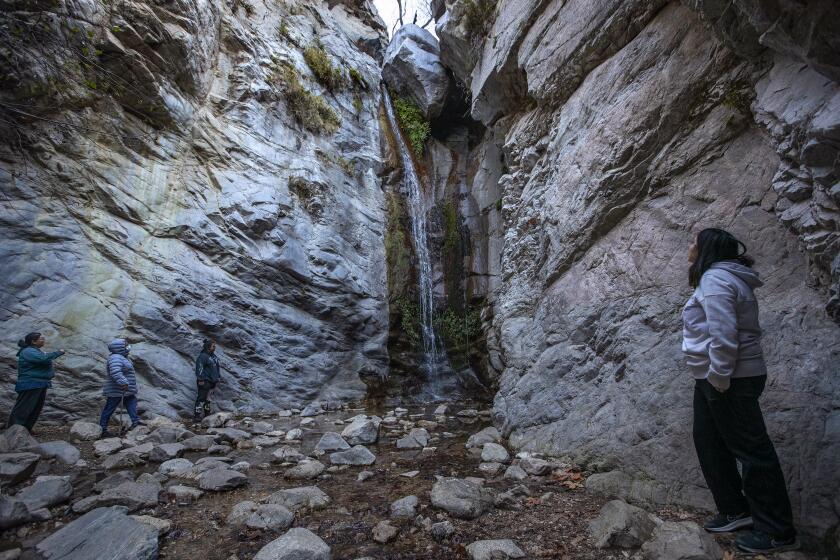Editorial: How California leaders can protect the environment from another Trump administration

- Share via
Of the many ways Donald Trump’s return to the White House promises to upend federal policy, few are more predictable or damaging than the U-turn he and his allies threaten to take on climate change and environmental protection. Fortunately, California has considerable power to counter the onslaught.
Trump’s first administration rolled back more than 100 regulations on clean air and water, toxic chemicals and wildlife conservation. He called global warming a hoax, pulled out of the Paris climate agreement, shrank national monuments and appointed Environmental Protection Agency administrators who helped polluters at the expense of public health.
Many experts believe Trump’s election is a last “nail in the coffin” for efforts to limit global warming to 1.5 degrees Celsius. He did, after all, urge oil executives to underwrite his latest campaign in exchange for undoing environmental rules.
Given Republican majorities in the House as well as the Senate and the conservative Supreme Court’s hostility to environmental regulation, Trump’s anti-environmental excesses will have to be checked at the state and local levels.
To that end, as part of his plan to wage a second high-profile campaign against Trump’s policies, Gov. Gavin Newsom has called a special session of the Legislature to ready California’s legal defense. Newsom, state Atty. Gen. Rob Bonta and other leaders in California and like-minded states can form an important bulwark against attacks on environmental protections, much as they did eight years ago. Former state Atty. Gen. Xavier Becerra filed more than 100 lawsuits against the first Trump administration, many concerning environmental matters, and won far more than he lost.
Editorial: Americans voted for Trump. Here’s what they chose — and the hope for all those who didn’t
Voters picked a leader who embraced authoritarianism, division and dehumanization. Those who chose Kamala Harris, including in California, aren’t without recourse.
But California officials can’t just play defense. They should use the state’s power and influence to mount a pro-environment offense, counteracting as much of the impending damage as possible.
With Trump’s team expected to kill President Biden’s electric vehicle tax credit, among other reversals, California can cement its reputation for consistently committing to its climate policies. A federal retreat from those policies will make the United States less competitive by ceding leadership on clean energy technology to China, Europe and other rivals. The strength and stability of the world’s fifth-largest economy, meanwhile, makes it an attractive innovation and investment partner while the federal government seesaws chaotically. That worked in California’s favor in 2019, when Ford, Honda and other automakers sidestepped the Trump administration’s efforts to weaken emissions standards and made a deal with California, citing the need for “regulatory certainty.”
“It wasn’t that they hated Trump,” said Mary Nichols, who chaired the California Air Resources Board at the time. “They wanted relief, but they wanted to have the discussion with people driven by science and data, not ideology.”
Measure G didn’t grab as much attention as others, but the wonky reform package could help Los Angeles County make progress on its jail, homelessness and more.
Also bolstering California’s position is a climate and energy landscape that has shifted dramatically in eight years, putting Trump’s agenda at odds with economic realities.
Electric vehicles are surging globally. One in five new cars sold are now battery-powered, with 1.7 million electric vehicles expected to be sold in the U.S. this year, more than eight times more than at the start of Trump’s first term. More than 40% of the nation’s electricity now comes from carbon-free sources, twice as much as in 2016.
The Inflation Reduction Act, the landmark climate law Biden signed, has unleashed a boom in electric vehicle and battery manufacturing and other clean energy technology that has disproportionately benefited red states and districts. While Trump has pledged to “rescind all unspent funds” under the law, 18 House Republicans have urged Speaker Mike Johnson (R-La.) not to repeal its clean energy tax credits, noting that they have “spurred innovation, incentivized investment, and created good jobs in many parts of the country — including many districts represented by” Republicans.
There are three more proposals, including the Chuckwalla Mountains, to add to California’s national monuments. Biden should act on them before his first term is up.
Trump may face pressure not to renege on commitments to cut greenhouse gas pollution from other unexpected places. The head of Exxon Mobil cautioned him against withdrawing from the Paris agreement on the grounds that the world needs a system to manage emissions.
Then there are obstacles of the self-imposed variety, including Trump’s choice to head the EPA: former Rep. Lee Zeldin of New York, whose main qualification seems to be loyalty. Zeldin’s lack of environmental experience could impede efforts to dismantle regulations, which takes loads of expertise, legal rigor and time.
Trump’s plan to purge the federal ranks of career civil servants and replace them with loyalists could further undercut his ability to roll back regulations, said Ann Carlson, a UCLA environmental law professor and former acting administrator of the National Highway Traffic Safety Administration. “The reality is you can’t get anything done without good civil servants,” she said.
Still, Trump can do real damage by going after the states trying to deal with climate change. Expect new efforts to revoke California’s waivers to set tougher vehicle emissions standards, several of which have yet to be approved by Biden’s EPA. The state’s ability to respond to climate-fueled disasters is also in jeopardy: Trump has repeatedly threatened to withhold federal aid to fight California wildfires, and the Project 2025 playbook for his second term calls for dismantling the National Weather Service.
For its own safety, California will need creative new policies that can stand on their own. That means tough measures from state regulators such as the state Public Utilities Commission and Air Resources Board and local authorities such as the South Coast Air Quality Management District, which has dragged its feet for years in advancing stricter rules for some of Southern California’s biggest polluters, the ports of Los Angeles and Long Beach.
Local leaders such as Los Angeles Mayor Karen Bass will need to do more. So far, she has failed to use her control of the Port of L.A. to take meaningful steps to clean up dirty diesel emissions.
We are facing the threat of years of lost ground on climate at a moment when we can ill afford it. It’s time for state and local leaders to get to work and show that in spite of a second Trump administration, environmentally responsible policy is still possible if they fight for it.
More to Read
A cure for the common opinion
Get thought-provoking perspectives with our weekly newsletter.
You may occasionally receive promotional content from the Los Angeles Times.













